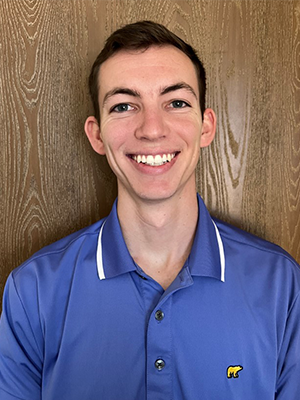Undergraduate Researchers Present at Statewide Events

Undergraduate students from Psychology, Kinesiology and Health Science, and Communicative Disorders and Deaf Education have taken advantage of opportunities to present their research to scholars and leaders across the state this January and February.
Research on Capitol Hill, an annual undergraduate research conference held at the Utah State Capitol Building, took place on January 20, and the Utah Conference for Undergraduate Research will be held on February 17 at the University of Utah.
Between the two conferences, six student researchers from the Emma Eccles Jones College of Education and Human Services will present their research and findings. Learn more about each student’s work below.
Research on Capitol Hill (ROCH)

Mitchell Olsen
Mitchell Olsen, Psychology
A SWOT Analysis on Utah's Youth Sport Landscape
In 2018-2019, 38,861 boys and 28,459 girls participated in high school youth sport in Utah. These numbers are just a fraction of the total youth sport participation in the state when factoring in land use, recreation, and club sports. Funded by a grant from the Daniel's Fund, this project is researching the youth sports landscape across Utah, New Mexico, Wyoming, and Colorado. As the state lead for Utah, Olsen collected data and conducted a SWOT (strengths, weaknesses, opportunities, and threats) analysis of the sports landscape in the state.
Olsen’s surveys and interviews with parents of youth, sport administrators, and coaches revealed that the roots for youth sport participation in Utah are strong. Across all kinds of communities, youth sport is supported in a number of ways and a strength in our state. Olsen also gathered data suggesting that sports could be contributing to the poor mental health of Utah youth, something he experienced himself as a young athlete who felt pressure to perform without receiving the appropriate mental training to match. He also found a disparity in access to youth sport in rural communities based on sex, age, and family income, and looks forward to continuing this research to further explore aspects such as race and impact on youth mental health.
Utah Conference on Undergraduate Research (UCUR)

Haven Broadhurst
Haven Broadhurst, Communicative Disorders & Deaf Education
Evaluation of Automated Transcription for Language Sample Analysis: The Impact of Accent on Word Error Rates
Language sample analysis is an unbiased, reliable way for speech language pathologists to gather information about someone’s language abilities. Although many professionals consider it a critical part of assessing language disorders, the procedure can be very time-consuming. This study sought to expand on recent research evaluating Google Cloud Speech (GCS), an automatic speech recognition software, as a transcription tool to help make language sample analysis easier to conduct.
Although previous studies have focused on monolingual English-speaking children, Broadhurst’s research assessed the use of GSC with bilingual Spanish-speaking children between the ages of 6 and 11 to examine the effect of accented speech on automatic speech transcription accuracy. The team found that on average, 38% of words were incorrectly transcribed. However, a follow-up analysis revealed that there was not a significant difference in this rate of error between audio from children with perceived accents and those without, meaning that GSC may prove to be a useful tool for speech-language pathologists to use in assessment of accented language.

Tess Crawford
Tess Crawford, Communicative Disorders & Deaf Education
Does an audiologist's person-centered discourse during a hearing aid orientation effect the patient's self-efficacy?
In audiology, hearing aid orientations are often standardized and clinician-centered, which can result in miscommunications between clinicians and their patients. This study aimed to determine whether the manner in which a videoed clinician orients an individual to hearing aids affects their self-efficacy and comprehension and how the patient's health literacy moderates this relationship. During the study, 100 participants with reported typical hearing were randomly assigned to view a video of a clinician orientating them to hearing aids in either a person-centered or a clinician-centered manner. The person-centered video avoided lengthy details, clearly explained tasks with a hearing aid as a model, and refrained from medical jargon, while the clinician-centered video highlighted multiple pieces of information, provided superfluous information, and included a large amount of medical jargon. Participants then completed a self-reported self-efficacy survey and competed a comprehension assessment.
Although Crawford’s team is still in the process of completing data collection, they predict that participants who view the person-centered video will have a higher self-efficacy score and comprehension than their study counterparts. They also predict that a participant’s health literacy levels, measured before the study, will also play a role in their comprehension. Crawford hopes that this data will support the need for audiologists to communicate more effectively with their patients, leading to an increase in the motivation for continued hearing aid use and result in improved overall hearing health.

Tate Burch
Tate Burch, Kinesiology & Health Science
Differences in Bone Data Between Sexes Despite Similar BMI for University Club Sport Athletes
The body mass index is a useful tool to measure weight adjusted for height, but it has a limited ability to identify other variables specific to an individual's unique composition. This can lead to inaccurate inferences about body composition between individuals with similar BMI values. The objective of this study was to analyze bone mineral content and bone mineral density and their relation to the measured BMI of university club sport athletes.
Data from 206 athletes revealed significant differences in bone mineral content and density between men and women, despite their BMI being similar. Males had significantly greater bone mineral content and density compared to females. Interestingly, the lowest and highest bone mineral density values occurred in the same sport, with female gymnasts having the lowest and male gymnasts having the highest. From this research, Burch and his team conclude that although BMI can be a practical tool for identifying weight categories, it should not be used to make inferences about bone mineral density and bone mineral content.

Alyssa Evans
Alyssa Evans, Kinesiology & Health Science
Fat-Free Mass Index (FFMI) of University Club Sport Athletes
Fat-free mass is the total mass of all the parts of your body that contain no fat. This includes organs, bone, muscles, and the body’s water content. Fat-free mass index (FFMI) helps indicate the body's muscle development and can help prevent injury. The objective of this study was to compare measured FFMI between university club athletes within their sport.
Evans and her team used advanced body measurement technology to measure body volume, bone mineral content, and total body water in 118 club sport athletes. Their findings revealed a significant difference in FFMI between male and female athletes, with men having a greater FFMI compared to women. For sports with more than 1 participant tested, women's lacrosse had the lowest FFMI and powerlifting had the greatest FFMI. For both men and women, FFMI values generally fell in the same range for athletes within each sport. This data can be used to form a database of average FFMI values for university club sports athletes.
Jacob McBride, Kinesiology & Health Science
Measured Thoracic Gas Volume Versus Two Equations
Body composition, or body fat mass relative to total mass, is important to a person's health and physical performance. One way to measure body composition is with a Bod Pod, a computerized, egg-shaped device that measures your body’s weight and volume to determine your body density and calculate your percentage of body fat. In order to determine a person’s body volume from the Bod Pod, the volume of air in their lungs (called thoracic gas volume, or TGV) during a normal breath must be measured or predicted.
To determine the best method of obtaining accurate measures of body composition, McBride and his team analyzed data from 26 university club athletes to compare measured lung volume to the volume predicted by the Bod Pod and the volume as predicted by an equation. They found that the Bod Pod overestimated athletes with a small TGV and underestimated athletes with a large TGV, and TGV calculated with the equation also exhibits some bias (though not as significant). Researchers recommend measuring TGV whenever possible and using the equation method for prediction when needed to obtain the most accurate measures of body composition.

